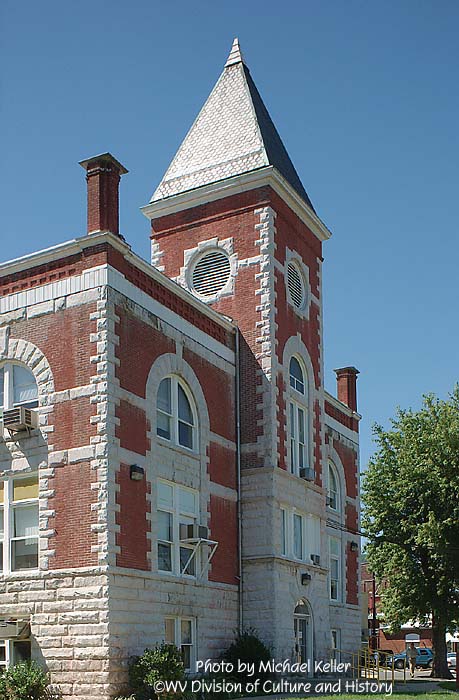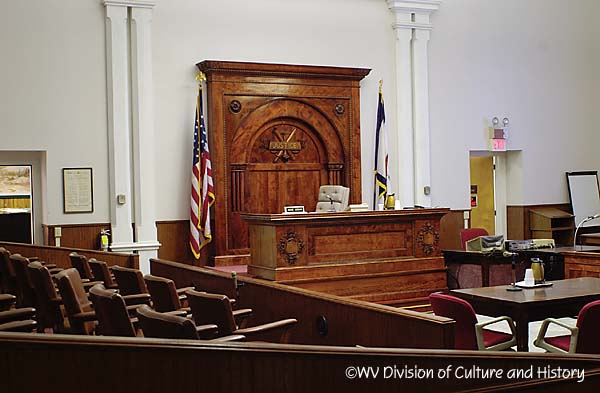History of West Virginia County Courthouses

Mineral County Courthouse
“A country whose buildings are of wood, can never increase in its improvements to any considerable degree...Whereas when buildings are of durable materials, every new edifice is an actual and permanent acquisition to the state, adding to its value as well as its ornament.”
Thomas Jefferson
Notes on the State of Virginia, Query 15, 1787
As architectural monuments, West Virginia’s county courthouses are more than places where county governments conduct business. They also stand as symbols of democracy and freedom and represent a community’s wealth, pride and aspirations. The idea of architecture as a symbol comes from Thomas Jefferson, who, in addition to being one of our country’s founding fathers, was a self-taught architect. For him, architecture was a way to break free from colonial exploitation and educate a young nation about new social ideals such as liberty, self-rule and the right to pursue happiness. Jefferson felt these ideals were best represented by classical buildings found in ancient Rome and Greece. His enthusiasm gave rise to the Greek Revival style of architecture, which was popular from about 1820 to 1850. Over the past 200 years, as our communities have changed, so have our ideas about architecture and how to represent these various ideas in buildings built for public and government use. The variety of architectural styles displayed by West Virginia’s county courthouses, when looked at as a whole, present us with a tangible link to our state’s history and help us understand how West Virginians perceived events and trends that occurred at the national level.
Fifty of West Virginia’s 55 counties were formed before 1863, the year western Virginia became its own state. As counties were created, courthouses were built to provide housing for newly formed county governments. These courthouses often became the centers of the community, providing space not only for trials and the storage of public records, but also for town events and meetings. Many of West Virginia’s original courthouses, especially those constructed in counties formed at the turn of the 19th century, were built of logs, an expedient and temporary solution to the immediate need for shelter. As soon as it was feasible however, the log buildings came down and sturdier structures of brick and stone were erected. Through the years, as county economies changed and their governments grew, early courthouses were often replaced with larger versions or were remodeled. Wood County, for example, has constructed a total of five county courthouses since its creation in 1798, while the current courthouses in Berkeley and Kanawha Counties have each undergone three phases of remodeling. Economic growth and the need for expansion often gave counties an opportunity to construct buildings in styles that reflected their new status. Today, most of West Virginia’s existing county courthouses were built between 1880 and 1920 (totaling 27), a period when the state was experiencing prosperity resulting from an industrial boom.
Hardy and Randolph Counties still retain the courthouses that were built to replace the original log structures (Hardy c.1792; Randolph c.1808). Together they reflect a period in our country’s youth when most of the United States was wilderness and many small towns were just starting to develop. Typical of the period, the courthouses are two-story, rectangular-shaped brick buildings, but have gable-end roofs rather than the more common hipped roof. Although their architectural details vary, they generally reflect the British-influenced Georgian and Federal styles that were popular in the decades just before and after the Revolutionary War. If counties could afford it, courthouses of this period were often topped with a clock or bell tower, cupola or dome. Originally, the courthouses in Hardy and Randolph Counties were both adorned in this manner (Randolph County’s has since been removed) suggesting that early county officials felt it necessary to give a more stately appearance to what were otherwise fairly plain and simple buildings. Constructed before the influence of Jefferson’s classicism had reached West Virginia, the Hardy and Randolph County courthouses lack the classical details that became popular by about 1820.
During the years between 1820 and 1860 our country was swiftly expanding and changing. As the number of people moving to cities increased and urban areas expanded, government entities became more complicated and required more space. To meet this need, public and civic buildings increasingly became larger and more distinctive and were for the first time being designed for specific purposes. Meanwhile, ongoing archeological investigations in Rome and Greece during the mid-19th century helped to bring about a period of great nostalgia for the ideals and culture of the past. This, combined with the need for increasingly larger and distinctive buildings, enabled architects to take the Greek temple idea promoted by Thomas Jefferson and develop it into a style that became known as Greek Revival. Romanesque Revival architecture, which combined elements of both Greek and Roman buildings, and Gothic Revival architecture, in which buildings were constructed in the fashion of medieval Gothic cathedrals, also became popular between 1820 and 1860. Nationally, this period also saw the beginning of the industrial revolution, a trend that was evident in western Virginia as glass, pottery, and brick factories, salt and coal mines, as well as cotton and flour mills began to operate across the region. As a result, many western Virginia towns including Martinsburg, Wellsburg, Moorefield, Hartford, Wheeling, and Charleston experienced a period of growth. Today, five courthouses remain in West Virginia that date to this early period of industrial growth and nostalgia for the cultures of ancient Greece and Rome. Those in Brooke and Greenbrier Counties continue to exhibit the Greek ideals that were important at the time. Those located in Berkeley, Hardy and Jefferson Counties, for a variety of reasons, underwent later renovations that have altered their original appearance.
After the Civil War as industry continued to grow, towns and cities and their commercial areas increased rapidly in complexity and character. Architectural styles and tastes also changed. In an attempt to design buildings that would feel modern and reflect the renewed energy of American society, architects began to use elements of classical architecture in more imaginative ways rather than create exact copies of Greek buildings as they had before. Both Romanesque Revival and Gothic Revival (now referred to as High Victorian Gothic) styles continued to be popular during this period, especially for public buildings, but roof lines became very complex and exterior details and ornamentation became increasingly detailed and complicated. The use of contrasting colors of brick and stone to create polychromatic walls was also common. Italianate architecture also was popular during this period. In West Virginia for the first couple of decades after the Civil War, as industrial development continued to progress, people dealt with issues of statehood and education. Surviving courthouses from the period between 1860 and 1880 are located in Grant, Marshall, Mineral and Summers Counties. The earliest of these, an example of Romanesque Revival located in Mineral County, continues to exemplify the Victorian spirit that was prevalent during this time. Most notable are its exterior walls of contrasting brick and stone.
In 1876 America celebrated its centennial anniversary. Reminiscence about our colonial past helped revive an interest in the Georgian and Federal styles of architecture that were popular before and just after the American Revolution. In response, architects began to study and copy early examples of Georgian and Federal architecture. Initially, new buildings constructed in what became known as the Colonial Revival style displayed freely interpreted details and elements of earlier Georgian and Federal buildings. After about 1900 however, architects became more interested in historic accuracy and designed buildings that were more correct in their proportions and use of details. Braxton (c.1882), Pendleton (c.1924) and Wayne (c.1924) Counties in West Virginia built new courthouses in the Colonial Revival style of architecture. A fourth courthouse, located in Jefferson County, was remodeled in 1916 using colonial details. Although the courthouse in Braxton County was constructed early in the development of the style, all four buildings illustrate the historical accuracy that evolved later in the period. These courthouses serve to remind us of an era when Americans were moving into the rapidly growing and changing age of industry and machines and were looking to their roots with a sense of nostalgia.
After 1880, West Virginia’s oil, gas, coal, glass and chemical industries boomed, which created a large amount of wealth in many communities. This is visible statewide as county governments decided to remodel existing courthouses or build new ones. On a national level, business enterprises were gathered into great conglomerates and trusts. Andrew Carnegie, for example, consolidated the steel industry in Pittsburgh region by 1880, while the oil producing and refining business was combined by John D. Rockefeller. This era, often referred to as the Gilded Age, ushered in a new view of architecture. Architects moved away from a creative and eclectic interpretation of Classical forms, and instead designed buildings with a traditional sense of harmony and balance, such as in the Neo-Classical Revival style. Reflecting the wealth of the era, architects applied classical motifs to buildings with a varying degree of extravagance. This is especially true of Richardsonian Romanesque, and Beaux Arts styles of architecture. Italianate architecture also continued to be a fashionable way of exhibiting a community’s wealth. Beaux Arts courthouses in Cabell and Clay Counties, the Italianate courthouse in Lewis County, the Neo-Classical Revival courthouse in Boone County, and the Richardsonian Romanesque courthouses in Kanawha, Wetzel, and Wood Counties exemplify the variety of architectural styles and the spirit of this era especially well.

Courtroom in the Mineral County Courthouse
Boone County Courthouse
Braxton County Courthouse
Brooke County Courthouse
Clay County Courthouse
Harrison County Courthouse
Jefferson County Courthouse
McDowell County Courthouse
Marion County Courthouse
Mercer County Courthouse
Pocahontas County Courthouse
Randolph County Courthouse
Tyler County Courthouse
Wood County Courthouse
A History of West Virginia Courthouses
Architectural Styles